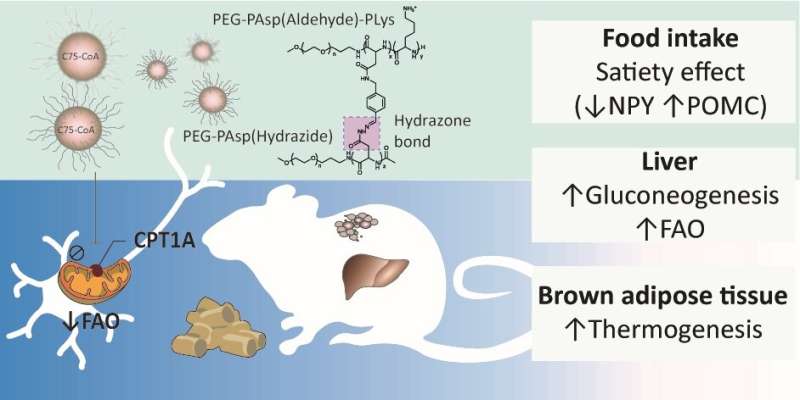Nanomedicine targeting hypothalamic lipid metabolism can be a potential approach for controlling obesity

The imbalance between dietary intake and output that results from metabolic disorders like obesity disrupts energy homeostasis. Despite significant advances in understanding the pathogenesis of these metabolic disorders, the prevalence of obesity and type 2 diabetes continues to rise and remains an unmet medical challenge.
The central nervous system (CNS) tightly modulates the physiological control of energy balance, having the hypothalamus as the focal area. Substantial evidence points to the hypothalamus’s lipid metabolism as a critical nutrient status signal influencing feeding behavior and peripheral metabolism. Remarkably, the accumulation of fatty acids (FAs) or their metabolites in hypothalamic neurons serves as a satiety signal and may reduce food intake and hepatic function.
The mitochondrial enzyme carnitine palmitoyl-transferase 1A (CPT1A), which facilitates the entrance of long-chain FAs for β-oxidation, is a critical target in brain lipid metabolism that regulates energy balance. Since CPT1A is highly expressed in central and peripheral tissues, its regulatory potential in the energy balance is based on two different interventions. In peripheral tissues (i.e., liver and adipose tissue), overexpression of CPT1A and induction of fatty acid oxidation (FAO) ameliorates insulin resistance and prevents body weight gain. Contrarily, in the CNS, CPT1A inhibition reduces food intake and body weight. Thus, specific inhibition of CPT1A in the hypothalamus but not in peripheral tissues offers a prospective treatment option for metabolic diseases that are characterized by an imbalance in energy homeostasis.
Researchers in a multi-institutional collaboration report that an inventively crosslinked polymeric micelle-type nanomedicine platform stably encapsulating the CPT1A inhibitor C75-CoA targets brain lipid metabolism to attenuate food intake and peripheral metabolism in mice. Several researchers from the University of Barcelona (Barcelona, Spain) also participated in this project. The work is published in the journal Biomaterials Science.
C75 is a well-known CPT1A inhibitor that is converted to its active coenzyme A (CoA) form in the hypothalamus. Enantioselective synthesis of C75 indicated that the (+)-C75 and (±)-C75-CoA adducts were the active forms inhibiting CPT1A despite the compound initially being found as a fatty acid synthase (FAS) inhibitor with a potent anorectic action via malonyl-CoA build-up. Hence, it is essential to transport (±)-C75-CoA directly into the brain for CPT1A inhibition and energy balance management to prevent the off-target effect on FAS and undesirable effects in the periphery.
The current publication reports the development of a robust core-crosslinked polymeric micelle (PM)-type nanomedicine with a high CPT1A inhibitor (±)-C75-CoA entrapment efficiency. The crosslinked PM has demonstrated excellent biological activity upon delivery of the CPT1A inhibitor in brain cells, particularly to neurons, after intracerebroventricular (ICV) administration making the crosslinked PM valuable for in vivo applications.
Furthermore, compared to the free drug, central administration of this (±)-C75-CoA-loaded core-crosslinked PM significantly reduced food intake and body weight in mice while also significantly regulating appetite-related neuropeptides, activating specific hypothalamic regions neuronally, and changing the expression of metabolic biomarkers in peripheral tissues.
Novelty and significance of this study
Treatments for metabolic diseases such as obesity or diabetes that control feeding, body weight, and glucose homeostasis are insufficient due to the difficulty of reaching specific brain targets. The current study reports on the first nanomedicine-based platform that acts on a brain target to drive a rapid modulation of food intake and peripheral metabolism, offering an innovative approach to managing metabolic diseases. The critical significance of this study are as follows:
- The core-crosslinked polymeric micelle-based nanomedicine used in this investigation allows the encapsulation of a drug that modifies lipid metabolism in the brain, a target hard to reach with conventional formulations.
- The effective delivery and higher neuronal uptake of the drug was evidenced in the potent and rapid satiating effect and significant body weight loss induced by central administration of core-crosslinked polymeric micelle loaded with C75-CoA in mice, as well as in the substantial regulation of appetite-related hypothalamic neuropeptides and neuronal activation of hypothalamic nuclei involved in feeding behavior, which were not observed in response to free (±)-C75-CoA treatment.
- This research can potentially create and validate a new generation of nanomedicine-based strategies by focusing on brain lipid metabolism to control food and body weight.
- In addition, this work emphasizes the significance of nanotechnology beyond its current biological uses. It makes it easier to comprehend the early stages of energy balance (i.e., acute satiating actions), which is critical for the emergence of complex disorders like obesity and diabetes.
More information:
Jesús Garcia-Chica et al, Nanomedicine targeting brain lipid metabolism as a feasible approach for controlling the energy balance, Biomaterials Science (2023). DOI: 10.1039/D2BM01751B
Provided by
Innovation Center of NanoMedicine
Citation:
Nanomedicine targeting hypothalamic lipid metabolism can be a potential approach for controlling obesity (2023, March 1)
retrieved 1 March 2023
from https://phys.org/news/2023-03-nanomedicine-hypothalamic-lipid-metabolism-potential.html
This document is subject to copyright. Apart from any fair dealing for the purpose of private study or research, no
part may be reproduced without the written permission. The content is provided for information purposes only.
For all the latest Science News Click Here
For the latest news and updates, follow us on Google News.

